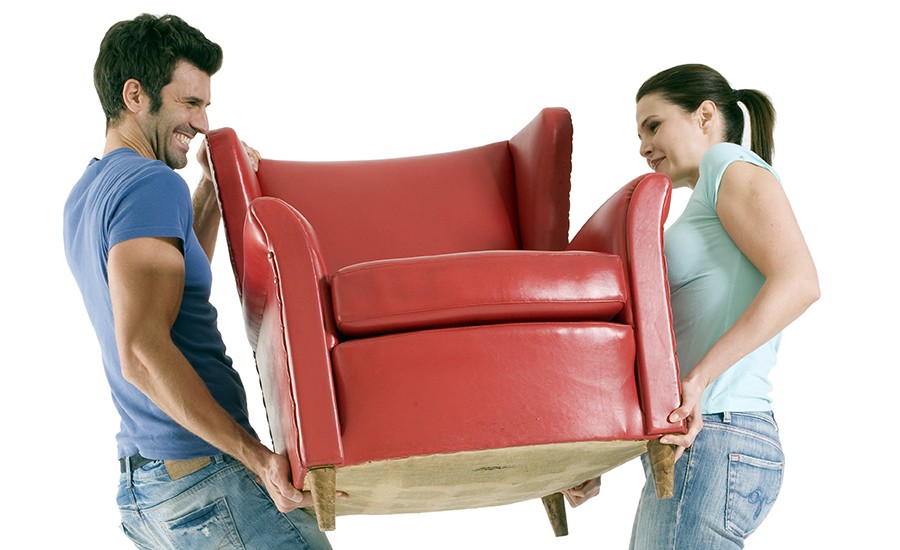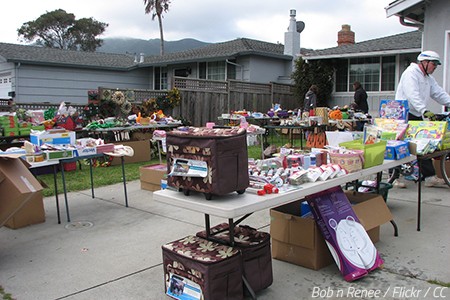Moving furniture by yourself be can trickier than you think.
First of all, you should ask yourself the question of whether it’s really worth the trouble of paying a good amount of money to transport any furniture pieces at all when you can purchase brand-new furniture after the move.
Secondly, most household furniture is both heavy and big, so you’ll have to plan enough time to disassemble it partially. What’s more, packing furniture for a move is never as easy as it may seem.
And thirdly, lifting and carrying heavy furniture is a risky job that can lead to either property damage or personal injuries, or even both!
Are you ready for the furniture moving challenge?
Here are the DO’S and DON’TS when moving furniture to a new home.
DO’S when moving furniture

The best way to move furniture is when you know exactly what you should do to finish the task with zero chances of property damage or personal injuries.
- DO inventory all the furniture in your home and make an informed decision about what to do with each piece. Base your judgment on the current condition, quality, functionality, usefulness, and sentimental value.
- DO go through your furniture pieces and decide which ones you’ll move with you, if any at all. Bear in mind that since most furniture items are both heavy and big, you’ll be forced to pay good money for their transportation. Is it really worth it?
- DO create a floor plan of the new home and with its help, determine the necessity to move your furniture to that new place. Sometimes it’s not only about the increased moving cost when hauling furniture across the country but about how those pieces may not match the interior of the new apartment or house, or worse – may prove to be too big for it.
- DO create a floor plan of the new home and with its help, determine the necessity to move your furniture to that new place. Sometimes it’s not only about the increased moving cost when hauling furniture across the country but about how those pieces may not match the interior of the new apartment or house, or worse – may prove to be too big for it.
- DO gift to friends or family members any furniture items that you’re not moving but you know that somebody you care about wants them or needs them. In reality, that’s the easiest way to get rid of furniture before moving – furniture that’s still in good condition and still perfectly usable.
- DO sell the furniture that you’re not moving and nobody of your friends needs or wants. After all, any extra cash you earn from the sale will help you cover some of the moving expenses, which is always a plus, especially when moving on a budget.
- DO measure the dimensions of your large furniture pieces – height (H), diagonal height (DH), width (W), depth (D), and diagonal depth (DD). Then, measure up all the doorways and hallways along the way out of the home to determine whether you are likely to run into any problems of the furniture-won’t-fit-through-doors type.
- DO assess each furniture moving case separately. Whenever possible, remove any protruding parts that can be safely detached – most often, those are legs, arms, and decorations. Leave the large furniture piece as bare as possible.
- DO disassemble any furniture pieces that appear to be too big to go safely through doorways or go around tight corners. How do you do that? Take a look at the construction manual of the furniture item in question and work your way backward. If unsure how to proceed, consult with a friend who’s good at those kinds of things or get in touch with reputable furniture movers for assistance.
- DO place small fastening elements in sealable plastic bags while you’re partially disassembling some of your large furniture. Keep in mind that bolts, nuts, screws, and washers can be easily misplaced or lost during a chaotic house move.
- DO consider removing all fragile furniture components such as glass doors, shelves, panels, etc. Be sure to protect those breakable items separately, well wrapped in wrapping paper and bubble wrap.
- DO get hold of quality packing supplies to protect furniture when moving: furniture blankets (of course!), stretch wrap, bubble wrap, wrapping paper, sheets of cardboard, painters’ tape, and regular packing tape.
- DO wrap in bubble wrap all fragile furniture components that you haven’t been able to remove for safer transportation. That is especially true for legs and other protruding parts that can easily be damaged when accidentally hit against something.
- DO position pieces of thick cardboard around furniture corners to protect those damage-prone areas. Remember that such furniture protection steps can make a big difference on the day of the move.
- DO secure all furniture components that may spring open during transport and lead to an accident – doors, panels, drawers, and so on. Use pieces of twine or a painters’ tape to do that, and never regular packing tape that tends to leave bad glue residue on delicate furniture surfaces.
- DO cover with protective blankets all the surfaces of the furniture items you’re moving. Furniture blankets provide outstanding protection thanks to their thick padding. However, if you don’t have those, regular blankets should also do the trick nicely.
- DO take a walk along the intended exit path out of the house and make sure there are no obstacles of any kind that may cause trouble while you’re carrying heavy furniture. Also, all pathways should be clear of dust, water, mud, or snow.
- DO ask your friends to give you a hand when moving large and heavy furniture. In most cases, you’re going to need at least two more helpers to get the job done without any property damage or personal injuries of any kind. As a rule of thumb, the more people you’ve got helping you move your furniture, the faster and safer you’ll manage that hard task.
- DO make your move easier and safer by securing the necessary moving equipment: furniture sliders and a moving dolly. You can rent those pieces of equipment from a local moving company or purchase them from a home improvement store. That’s right, the investment will be well worth it.
- DO use furniture sliders, strategically placed under each furniture leg or side, to avoid floor damage when moving large and heavy furniture items. Remember that while furniture sliders make the task of sliding big furniture almost effortlessly (and safely too!), you need to remember to use felt sliders for hardwood and tiled floors and plastic or rubber sliders for carpeted floors.
- DO use a furniture dolly to transport those heavy furniture pieces from your home to the awaiting moving vehicle, and then unload the heavyweight objects from the truck and get them inside the hew home.
- DO use the proper lifting techniques when moving furniture: keep your back straight, always bend your legs, NOT your back, and use the strong thigh muscles as a lifting device.
- DO wear comfortable clothes, and more importantly – closed-toe shoes with anti-slip rubber soles and possible ankle-support too. Also, wear high-quality work gloves to maintain a good grip and to protect your hands and fingers when moving heavy furniture.
- DO try solving the problem at different angles if you accidentally get stuck in a small doorway, a narrow hallway, or a tight corner while moving a large piece of furniture like your oversized couch, for example. Sometimes approaching a problem area at a (slightly) different angle will let you get out of it all as a winner.
- DO attempt to squeeze large furniture pieces through smaller openings if you need a few inches of extra space. Do this maneuver only with furniture that has soft sides that won’t get damaged when compressed a bit – for example, sofas and couches.
How to move heavy furniture by yourself
DON’TS when moving furniture

Moving furniture from one home to another is never an easy thing to do for a number of obvious reasons: most pieces are rather heavy and their dimensions are larger than what a non-professional like yourself can handle safely.
However, once you are familiar with what you shouldn’t do when moving furniture, then the entire furniture moving operation will become easier as you’ll already be aware of the critical moments when you’ll have to pay special attention to avoid trouble.
- DON’T bother moving furniture that’s really not worth the time and money to be moved. How do you know? When the furniture pieces you own are too old and too worn out, they won’t be worth the moving expenses. Also, ready-to-assemble furniture like IKEA does not move well and is not likely to survive the move intact.
- DON’T move furniture that is too dusty and dirty. ONE – you don’t want that dirt to go into the new home, and TWO – the presence of abrasive particles could damage the surface of some of your more delicate furniture items.
- DON’T attempt to move super-heavy and super-large furniture without partially disassembling those pieces to make them smaller and lighter. Besides possible damage to your possessions or property damage, you also risk getting injured if moving any big furniture without disassembling it first.
- DON’T try to be a hero and move your furniture entirely on your own. Instead, be reasonable and ask your friends to help you out if you do decide that moving furniture is the right decision after all.
- DON’T assume that your pals will rush to your aid when they understand the nature of the job – moving heavy furniture cannot possibly be anyone’s favorite activity. Luckily, you always have a PLAN B where you hire furniture movers if your friends happen to be too busy to give you a hand.
- DON’T begin the furniture moving project unless you know exactly what it takes to protect those large items for the road. The acquisition of packing supplies is not enough – you’ll also need to know the best way to pack furniture for moving.
- DON’T use packing tape directly onto the furniture surfaces for fear of ruining the delicate finish of your possessions. Bubble wrap can also do its share of damage when it gets into direct contact with your furniture. The solution? Always use furniture blankets as the first layer of protection.
- DON’T try to slide heavy furniture along the floor without having placed suitable sliders underneath the load first. Bear in mind that you should be really careful to avoid any type of floor damage on the day of the move.
- DON’T rely on pure luck but make sure the furniture pieces you’re taking with you are well protected so that they arrive in the new home in perfect condition.
- DON’T underestimate the complexity of the job when moving furniture to a new home. If you have your doubts that you’ll be able to manage the heavy task without professional aid, then do what’s right for your favorite furniture items and hire the services of the best furniture movers in your area.
How to move furniture to another state
The post Do’s and Don’ts When Moving Furniture appeared first on The Moving Blog.







